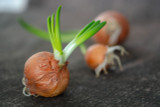How To Successfully Grow Onions From Seeds
Many recipes use onions to give a strong taste and smell. Growing onions from seeds is better than buying from the store. It saves money, lets gardeners choose from many types, and improves quality. First, choose the right seed and prepare the soil. Next, plant the seeds, take care of the seedlings, and harvest and store the onions. This post explains the benefits of the process.
Benefits of Growing Onions from Seeds
Growing onions from seeds offers several advantages over purchasing onion sets or transplants. Seeds offer more onion options for gardeners. They can grow uncommon or old-fashioned types that might not be sold as sets or transplants. Additionally, growing onions from seeds can improve quality, as the gardener has control over the growing conditions and can select the healthiest plants for their garden. Growing onions from seeds is cheaper than buying sets or transplants. Seeds are usually less costly, making them a more cost-effective option.
Choosing the Right Onion Seed
Selecting the right onion seed for your garden depends on several factors, including your climate, growing season length, and personal taste preferences. There are three main types of onion seeds: short-day, long-day, and day-neutral. Short-day onions grow better in the mild winter of the south. On the other hand, long-day onions prefer the longer summer days of the north. Day-neutral onions can be grown in most regions, as they are less sensitive to day length.
Choosing good onion seeds is essential, so make sure you buy them from a reputable supplier. Good seeds will grow better plants and give you a better harvest. This happens because high-quality seeds sprout more and grow into healthier plants.
Preparing the Soil
Onions thrive in well-draining, good fertile soil with a pH level that is between 6.0 and 7.0. To plant onion seeds, first till the soil to a depth of 8-12 inches. Next, add well-rotted manure or compost to improve soil fertility and drainage.
Testing the soil's pH level is also important. If the pH level needs to be adjusted, add lime to raise it or sulfur to lower it.
Planting Onion Seeds
The best time to plant onion seeds depends on your climate and the type of onion you are growing. Long-day onions are planted in spring, and short-day onions in fall or winter. Before planting, soak the onion seeds in water for a few hours to improve germination rates.
There are two main ways to plant onion seeds. You can use seed trays or plant them directly into the ground. Seed trays are used to start seeds indoors, and then the seedlings are moved to the garden. On the other hand, direct seeding is planting the seeds directly in the garden. To plant onion seeds, sow them about 1/4 inch deep and 1 inch apart in rows spaced 12-18 inches apart. Cover the seeds with a thin layer of soil and water them gently to ensure good soil contact.
Caring for Onion Seedlings
Proper care is crucial for the successful growth of onion seedlings. Regularly water the seedlings so the soil stays lightly moist but not too wet. Use a balanced fertilizer to help the young plants grow. Follow the instructions on the package for how much to apply and how to do it.
Protecting onion seedlings from pests and diseases is also important. Bugs like larvae, thrips, and aphids can damage onions. They can also get sick from onion smut and white rot. Monitor your seedlings closely and take appropriate action if any issues arise.
As the seedlings grow, thin them to a spacing of 3-4 inches apart to prevent overcrowding and promote healthy growth. Mulching around seedlings can help in many ways. It keeps the soil moist, prevents weeds from growing, and regulates its temperature. You can help the roots grow stronger by trimming the tops of the seedlings.
Recent Posts
-
The Secrets To Growing Radishes In Containers
Container gardening is a popular way to grow vegetables like radishes. Growing radishes in container …26th Jun 2023 -
How To Successfully Grow Onions From Seeds
Many recipes use onions to give a strong taste and smell. Growing onions from seeds is better than b …26th Jun 2023 -
How To Grow Radishes At Home: A Step-By-Step Guide
Growing your radishes at home can be a rewarding and delicious endeavor. These crispy and spicy vegg …26th Jun 2023





